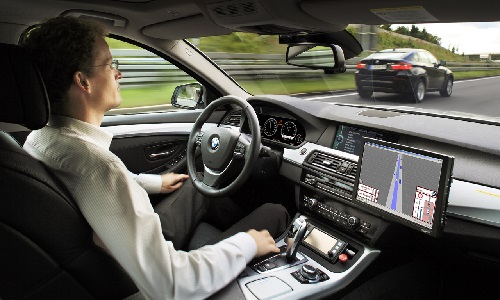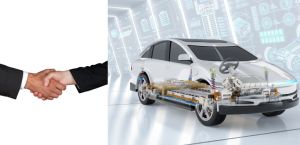By Jeff Sanford
Toronto, Ontario — May 21, 2018 — In this week’s AV Report: Ford begins to fall behind in the AV race, GM thinks about post-human-control interiors, glitches in the California test fleet and much, much more!
Wall Street analysts following the auto industry are beginning to work the AV story into their financial scenarios. This past week investment bank Piper Jaffray downgraded Ford stock. One of the reasons for the reduced outlook: The car company is falling behind in the race to bring an autonomous vehicle to market. According to the bank, “with U.S. vehicle sales slowly eroding, we think investors are looking for more fundamental changes from Ford and from automotive companies in general. Ford may yet capture its share of the $1 trillion dollar market for autonomous rides, but in our view, the company isn’t a leader in this market – at least not yet,” said the analysts. Piper Jaffray downgraded Ford stock to neutral from overweight. It also lowered its 12-month price target to $12, slightly above the current price.
A GM executive this week talked about how it is the company is beginning to think about the potential for redesigning the interiors of vehicles. The company’s vice president of global strategy was quoted in a recent article in the business media. The report quotes the exec as saying AVs will be “unrecognizable” from the inside of cars today. “The Detroit-based auto giant debuted an infotainment center-based marketplace, which allows users to make dinner reservations and purchase goods from retailers and gas stations, late last year. The automaker will likely consider including the marketplace in its self-driving car fleet, with the customized designs it’s developing, to create the engaging experiences needed to capture the millions of hours that’ll be available for media consumption in autonomous cars. This approach could also allow GM to act as a gatekeeper for its in-car ecosystem, enabling it to potentially block out certain rivals like Apple, as it looks to maximize revenue from its self-driving efforts. Additionally, this opens up a major opportunity for GM to license its designs to other companies. Every company working on autonomous technologies will likely be looking to grab a share of the media and content consumption inside self-driving cars. However, building an engaging in-car experience will require attracting numerous merchants and media companies as partners, potentially encouraging companies to forgo building their own designs and instead license one from GM,” according to the report.
A website for coders suggests that since 2012, the amount of computations the “largest AI training runs have performed have been increasing exponentially with a 3.5 month doubling time.” Learning-based software gets better the more experience the program has either in virtual or real environments. The programs being developed that allow computers to sort out the various objects detected by sensors require vast numbers of connections and comparisons to be made many times a second. The number of calculations the most sophisticated programs are making is now expanding at the rate similar to Moore’s Law, which is the observation that number of transistors scientists have been able to put on a chip has roughly doubled every 18 months. A similar exponential rate of expansion is taking place with the complexity and sophistication of AI programs. “Since 2012, this metric has grown by more than 300,000 times. Improvements in computers have been a key component of AI progress, so as long as this trend continues, it’s worth preparing for the implications of systems far outside today’s capabilities,” according to the blog.
At a time Tesla is facing more NHTSA investigations than ever, the company’s main technical contact with U.S. safety investigators has left the company. Elon Musk’s car company has suffered the exit of several top executives of late. The latest one to go is Matthew Schwall, Tesla’s contact with U.S. transport regulators. According to a story in the tech trade press the departure comes as, “the Silicon Valley auto maker races to develop driverless-car technology. His departure comes as the National Transportation Safety Board has been investigating multiple crashes. Tesla will be without two important executives just as the electric-car maker struggles to boost production of its first mass-market vehicle and faces doubts about its ability to raise cash.”
The California Department of Motor Vehicles recently released the latest stats that it new publishes regularly on the performance of AVs being tested in the state. A website devoted to the Apple company notes that the Cupertino-based tech giant now has the largest AV test program going on. Apple’s program is even larger than that of Google’s Waymo division. According to the California state data the tech giant, “now has 55 self-driving car permits and 83 drivers licensed to test the technology on the state’s roads. That puts Apple in second place, behind only General Motors’ Cruise division, which has 104 vehicles and 407 drivers. Apple’s permit number is staggering. The iPhone maker didn’t have a single permit in March 2017 and was awarded three permits in April 2017. In a little over a year, Apple has amassed the largest number of self-driving car permits of any tech company. Another story in the media discussed the moments when human drivers in the cars had to take back control of the AV from the computer. According to the report, “Cruise, like Delphi, said its cars had trouble when other drivers behaved badly. Other drivers had failed to yield, run stop signs, drifted out of their own lane and cut in front aggressively, all forcing human intervention, Cruise reported. Telenav, a connected-vehicle technology company, reported that its system didn’t always keep to the three-second following distance it was supposed to maintain between a car and the vehicle in front of it. Also, the system steered a vehicle too close to a lane boundary, parked poorly at times and mistook a bridge overpass for a car stopped in front. Google spin-off Waymo described one of its vehicles failing to see that a ‘no right on red’ signal had been turned on, and the company also cited hardware and software problems requiring disengagement.”
A news report notes that, “Mobileye, Intel Corp’s Israel-based autonomous driving unit, has signed a contract to supply eight million cars at a European automaker with its self-driving technologies. The deal, one of the largest yet for Mobileye, is a sign of how carmakers and suppliers are accelerating the introduction of features that automate certain driving tasks – such as highway driving and emergency braking – to generate revenue while technology to enable fully automated driving in all conditions is still years away from mass-market deployment.” Mobileye was bought by Intel last year for $15.3 billion. According to the Reuters report, there are, “some 27 million cars on the road from 25 automakers that use some sort of driver assistance system and Mobileye has a market share of more than 70 percent.” According to a Mobileye executive, “By the end of 2019, we expect over 100,000 Level 3 cars with Mobileye installed.” The Reuters report points out that, “In Level 3, the car is self-driving but the driver has about 10 seconds to take over if the system is unable to continue.” At its Jerusalem headquarters Mobileye is testing Level 4 tech in Ford Fusion hybrids. “In a test witnessed by Reuters reporters, these cars are able to drive on Jerusalem highways in midday traffic with no driver interference. [The executive] said that based on commitments from automakers, self-driving taxis – called robo-taxis – should start hitting roads around 2021.” The executive went on to note that about that time, “some of the more expensive luxury cars for personal use, and possibly some medium-priced vehicles, will use the same technologies – for an extra cost of about $12,000 per car.” In a few years time, “roads will be comprised of both human drivers and self-driving cars – which is why safety is paramount. [The source] added that while there are 40,000 fatalities on U.S. roads each year, society won’t accept that number from self-driving cars, although perhaps about 40,” according to the report.





































